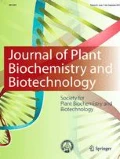References
Bock R (2014) Genetic engineering of the chloroplasts: novel tools and new applications. Curr Opin Biotechnol 26:7–13
Distelfeld A, Avni R, Fischer AM (2014) Senescence, nutrient remobilization, and yield in wheat and barley. J Exp Bot 52:1761–1768
Feller U, Anders I, Mae T (2008) Rubiscolytics: fate of Rubisco after its enzymatic function in a cell is terminated. J Exp Bot 59(7):1615–1624
c4rice.irri.org
Author information
Authors and Affiliations
Corresponding author
Ethics declarations
Conflict of interest
The author declare that he has no conflict of interest.
Rights and permissions
About this article
Cite this article
Rao, A.S. Conversion of C-3 plants into C-4 plants may lower the Rubisco amounts with negative effects on grain yield and protein concentration. J. Plant Biochem. Biotechnol. 25, 337–338 (2016). https://doi.org/10.1007/s13562-016-0371-9
Received:
Accepted:
Published:
Issue Date:
DOI: https://doi.org/10.1007/s13562-016-0371-9

